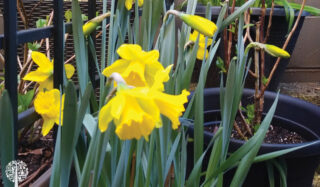There is nothing I don’t love about daffodils! They withstand heavy rain without flinching, and getting buried under a late-season snowstorm in mid-bloom is no big deal. Daffodils aren’t fussy about soil and will grow in sun or shade, and pests like snails, deer, and squirrels steer clear of them.
Yellow is the most common daffodil color, but they also bloom in white, cream, orange and pink. There are at least 25 different daffodil species, including jonquils and paperwhites, and up to 13,000 hybrids! There’s a daffodil out there to please every gardener. The blooms last four to six weeks, and they’re equally happy in containers, window boxes, or planted in the ground.
Planting Daffodils
Daffodils are planted like tulips, crocus, and other spring bloomers in the fall. Dig a hole six inches deep in the ground or container and place the bulb with the flat end down. Cover with soil, water them, and wait. For the best effect, planting the bulbs in groups of five to ten will make the biggest and brightest statement in the spring garden.

Growing Daffodils
Once daffodils are planted, they immediately start to develop a root system. The tips of the leaves emerge from the ground first, and tall flower buds begin forming at the plant’s base. As the stems get taller, the buds become larger and show colour. The growing cycle may stop and start depending on the weather. A mild start to the winter may encourage faster growth and have daffodils blooming in January. It happened in my garden this year!
If it suddenly becomes colder and daffodils have already broken ground, no problem. They will stop growing and wait patiently for the cold to pass before continuing their journey.
After Blooming
Daffodils use their foliage to create the food energy needed for another year of flowering. For this reason, it’s essential to let them die back naturally. A trick I’ve learned to keep the garden tidy while allowing nature to take its course is to tie the leaves into a knot or pin them together. Once the leaves are entirely limp and yellow, they can be cut back or left to decompose into the ground following the chop-and-drop method.
Clumps of daffodils can get large and overcrowded, which can cause a decrease in flower production. If this happens, dig up the bulbs, divide them, and replant about one-third after flowering.

Daffodil Drawbacks
The only drawback to this fantastic spring flower is that daffodils contain sap that is poisonous to other plants. Before mixing daffodils with other flowers in a vase, soak them in water for 24 hours to remove the sap. They can also be toxic to cats and dogs.
In England, daffodils are often referred to as Lent Lillies. It is the official flower of Wales where it’s said that if you spot the first daffodil of the season, the following year will be filled with wealth.
So, have I convinced you that daffodils are the star of the spring garden? They are the stars of mine.
See you next time as we grow and garden together!